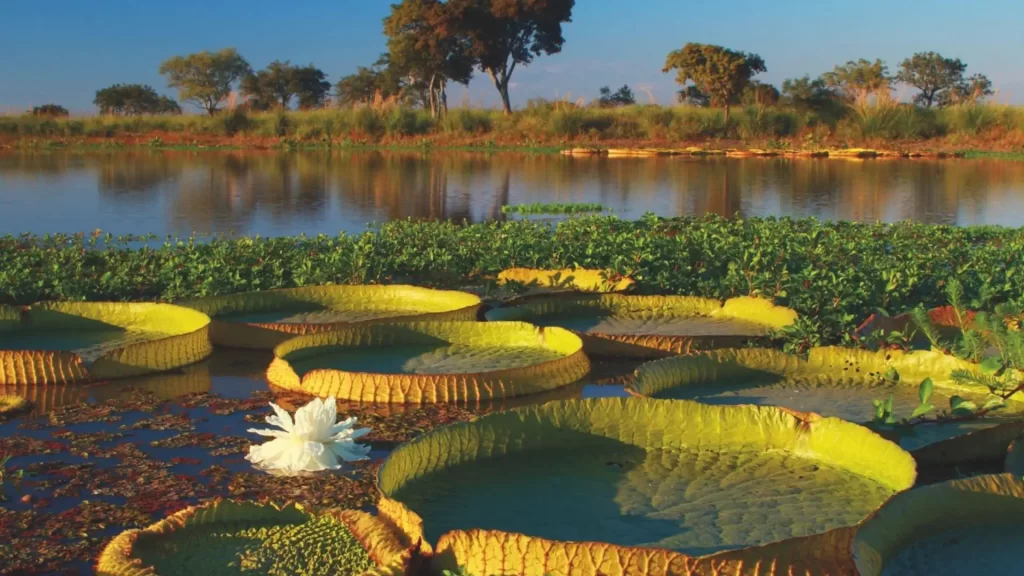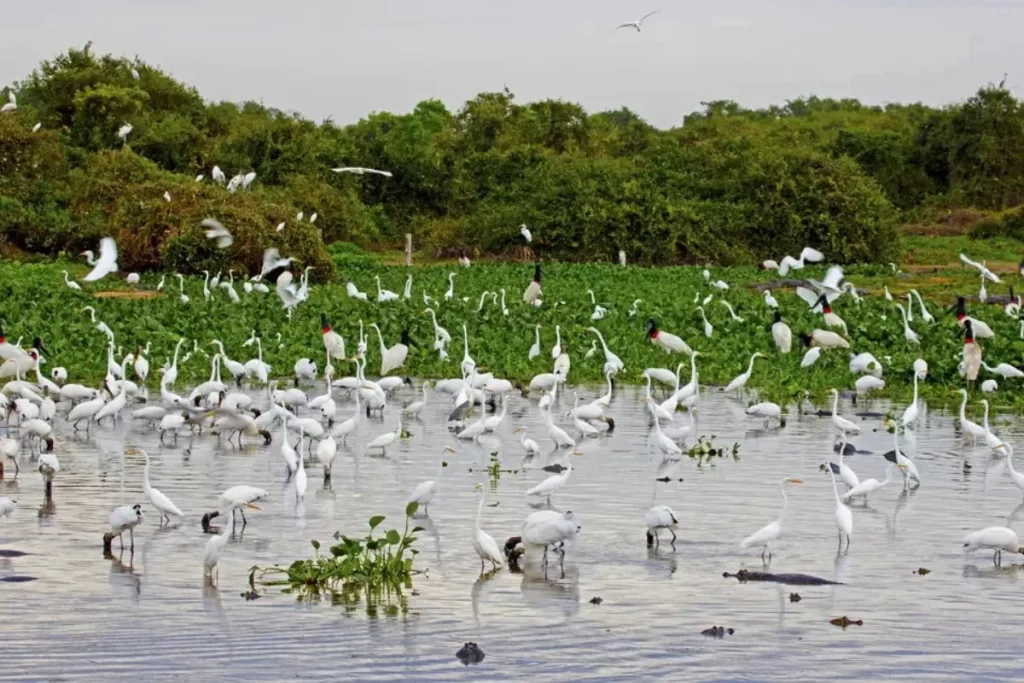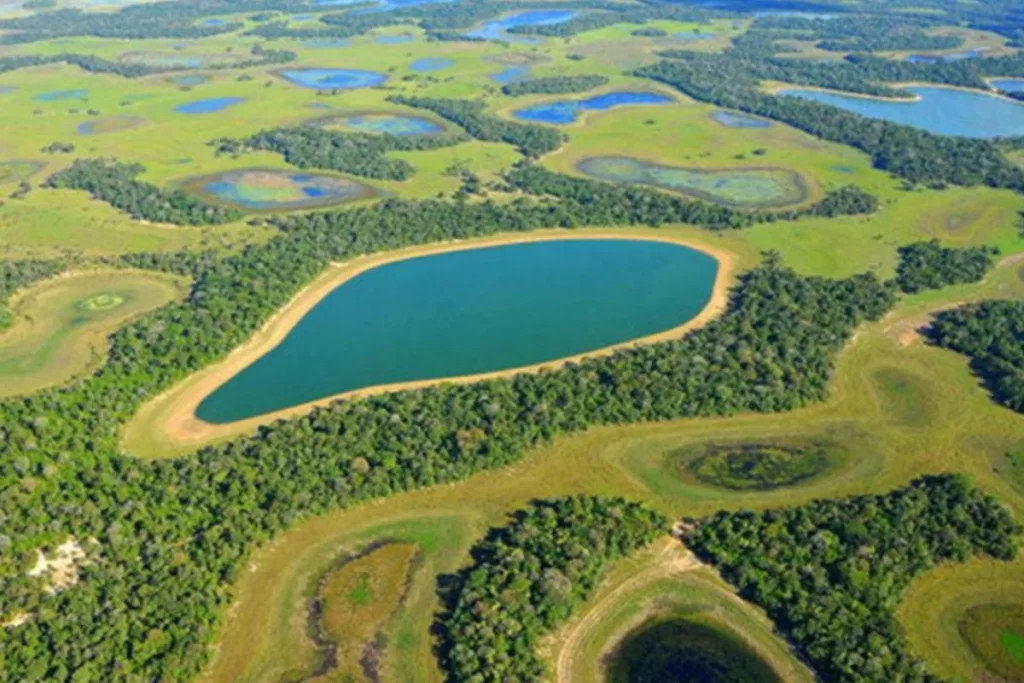
Brazilian Pantanal wildlife observation is one of the most rewarding nature experiences in the world. As the planet’s largest tropical wetland, the Pantanal stretches across the states of Mato Grosso and Mato Grosso do Sul. Unlike the Amazon Rainforest, where dense foliage often hides animals, the Pantanal’s open landscapes make it easier to spot wildlife like jaguars, capybaras, and macaws in their natural habitats. This guide will help you prepare for a memorable journey, showing when to go, what to bring, and how to travel responsibly in this unique ecosystem.
Table of Contents
ToggleBest Time to Visit the Pantanal
Dry Season: Best Time to See Jaguars in the Pantanal
During the dry season, from April to October, wildlife gathers near shrinking water sources. This makes animals easier to spot. This is the ideal time to visit if your goal is to see jaguars, especially in the northern Pantanal near the Cuiabá River. Jaguars often rest on riverbanks, and boat safaris offer excellent chances to see them in action. It also brings mild temperatures and lower humidity. Roads and trails are more accessible at this time.
Wet Season: Top Birdwatching Destinations in the Pantanal
Heavy rains fall from November to March. These transform the dry fields into vibrant lagoons, creating a flooded paradise. While jaguar sightings become rare during this time, the wet season is a haven for birdwatchers. Thousands of migratory birds arrive, adding to the Pantanal’s already impressive list of over 650 avian species. The scenery is lush and green, and the skies are often dramatic — a photographer’s dream.
Pro tip: Visit during the transitional months of May or October to enjoy the best of both worlds — good wildlife visibility and lush, colorful landscapes.
PUBLICIDADE

Essential Gear for Brazilian Pantanal Wildlife Observation
A successful wildlife tour depends not just on timing, but also on preparation. Bringing the right gear improves your safety and comfort. It also increases your chances of seeing rare animals in the wild.
- Binoculars and a zoom camera: Spotting jaguars or toucans from a distance requires quality equipment. A DSLR or mirrorless camera with a telephoto lens is ideal.
- Neutral, breathable clothing: Earth tones help you blend into nature, while moisture-wicking fabrics keep you cool in the heat.
- Insect repellent and sunscreen: Mosquitoes can be relentless, especially near water. High-SPF sunscreen is also essential under the tropical sun.
- Waterproof footwear: Trails may be muddy or flooded, especially during the rainy season.
- A waterproof backpack: Protect your gear, snacks, and essentials from sudden rain or river splashes.
When preparing your essential packing list for Brazilian Pantanal wildlife tours, consider the remoteness of the region. In many areas, shops are nonexistent, so arrive prepared.

Top Species for Brazilian Pantanal Wildlife Observation
The Pantanal is a natural sanctuary unlike any other. It supports one of the densest concentrations of wildlife in the Americas — and possibly the world.
Jaguars
The jaguar is the Pantanal’s top predator and perhaps its most iconic resident. These elusive big cats can weigh up to 100 kg and are known for their powerful build and striking rosette-patterned coats. Boat safaris from Porto Jofre are the best way to spot jaguars, especially between July and September.
Capybaras and Caimans
You’ll quickly become familiar with capybaras, the world’s largest rodents. Social and relaxed, they often gather in groups near riverbanks and lagoons. Nearby, you’ll likely see caimans, close relatives of alligators, basking in the sun or drifting silently in the water.
Giant Otters and Tapirs
Giant otters are endangered, playful, and vocal animals. You can often see them in small family groups near slow rivers. Their size and behavior make them a favorite among visitors. Meanwhile, the shy and solitary Brazilian tapir may occasionally make an appearance during early morning or dusk.
Exotic Birds
The Pantanal is a birdwatcher’s dream. Hyacinth macaws, jabirus, toucans, and kingfishers are just a few of the brightly colored species you may encounter. The open terrain makes birdwatching particularly rewarding — binoculars are a must.

Respecting the Pantanal’s Fragile Ecosystem
While the Pantanal welcomes visitors, it’s vital to remember that this is a sensitive ecosystem, under pressure from climate change, agriculture, and tourism. Your actions as a traveler matter.
Travel with local guides: Certified guides not only enhance your experience but also ensure your presence doesn’t disturb animal behavior or the environment.
Avoid plastic and single-use items: Use refillable bottles and eco-friendly toiletries.
Never feed the animals: Doing so disrupts natural habits and can cause harm.
Stay on designated trails: These paths are designed to protect flora and minimize erosion.
Following eco-friendly tourism tips for visiting the Brazilian Pantanal is essential. A sustainable visit ensures future travelers will be able to enjoy the same pristine beauty.
PUBLICIDADE
How to Visit the Brazilian Pantanal for Wildlife Observation
How to Reach the Brazilian Pantanal for Wildlife Observation
The Pantanal has two main gateways:
- Cuiabá (north): Ideal for those seeking jaguar safaris and boat-based tours.
- Campo Grande (south): Great for birdwatching and community-based ecotourism.
From either city, travelers can take private transfers or join guided tours to reach lodges located deep in the wetland.
Best Eco-Lodges for Wildlife Observation in the Brazilian Pantanal
Eco-lodges are the best way to experience the Pantanal. They offer not only comfort but also immersive, low-impact activities like sunrise hikes, nocturnal wildlife spotting, and river excursions.
Top-rated options include:
Refúgio Ecológico Caiman (south): Known for luxury and conservation.
Pousada do Rio Mutum (north): Great for families and birdwatchers.
Jaguar Ecological Reserve (Porto Jofre): Ideal for serious photographers.
Staying at eco-lodges in the Brazilian Pantanal for wildlife enthusiasts supports local conservation efforts and helps reduce environmental impact.
PUBLICIDADE
Exploring Pantanal Culture and Local Communities
Beyond its biodiversity, the Pantanal is home to pantaneiros — local people with a deep cultural connection to the land. Their traditions are influenced by cattle ranching, fishing, and an intimate understanding of the environment.
Many lodges now offer opportunities to visit small farming communities, where travelers can learn traditional cooking, attend local festivals, or ride horses through the open plains. This cultural interaction enriches your trip and promotes sustainable tourism by directly supporting the residents.
Safety and Health Tips for Visitors
While the Pantanal is safe for tourism, it’s essential to take precautions:
- Vaccinations: Yellow fever vaccination is strongly recommended.
- Travel insurance: Always have insurance that covers outdoor activities and remote areas.
- Hydration: Drink plenty of water and avoid untreated sources.
- Mosquito protection: Wear long sleeves at dusk and consider bringing a mosquito net.
Your unforgettable wildlife adventure in the Brazilian Pantanal will be far more enjoyable with proper preparation.
Ready to Explore the Pantanal?
The Brazilian Pantanal is a place where jaguars roam free, birds color the sky, and silence is broken only by the sounds of nature. It’s a region of serenity and wonder — ideal for those seeking authentic experiences far from the crowds.
Whether you’re a wildlife photographer, bird lover, or simply curious about Brazil’s wild side, the Pantanal offers a once-in-a-lifetime journey. From expert-led safaris to quiet canoe trips, your adventure in the world’s largest tropical wetland is waiting.
For more Brazilian nature destinations, visit our guide on Brazil’s top ecotourism destinations.

Pingback: São Paulo Travel Guide: Best Tourist Attractions and Where to Stay